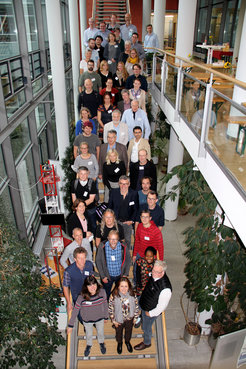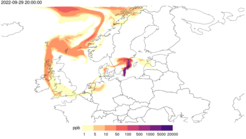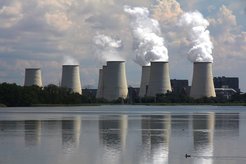Press release: On the trail of greenhouse gases
The Integrated Greenhouse Gas Monitoring System (ITMS) records where greenhouse gases are released and absorbed in Germany.

The sources and sinks of greenhouse gases in Germany are to be better recorded and monitored in the future. This is the goal of the Integrated Greenhouse Gas Monitoring System (ITMS) for Germany, which was officially launched with a three-day meeting from 18 to 20 October 2022 at the Max Planck Institute for Biogeochemistry (MPI-BGC) in Jena. The ITMS is funded by the German Federal Ministry of Education and Research (BMBF) and aims to provide the German government and the public with reliable information on the status and development of greenhouse gas fluxes. What is new about it is that the sources (release) and sinks (uptake) of greenhouse gases can be determined independently, now based on observations: Based on the measured concentrations in the atmosphere and by means of current modelling of the source and sink processes as well as the meteorological transport, new calculations with a high degree of reliability are made possible. It is precisely trustworthy data that is of particular relevance for a fact-based policy to mitigate climate change, for the control of the trade in CO2 certificates, and the path to a climate-neutral economy (NetZero).
At the kick-off meeting from 18 to 20 October 2022 at the MPI-BGC, the participating research partners met with an extended circle of interested research groups to agree on the specific plans for the first four-year project phase.
Federal Research Minister Bettina Stark-Watzinger explains: "Tackling climate change is a human task that we will only succeed in with research and innovation. With the Integrated Greenhouse Gas Monitoring System for Germany, greenhouse gas sources and sinks can be directly monitored for the first time. This gives us a more accurate picture of the situation for better climate protection and allows us to check climate protection measures for their effectiveness."
Inverse modelling finds sources and sinks
Sources and sinks of greenhouse gases as well as their origin on the surface of our earth can be determined with the help of "inverse modelling". This method uses real observation data of atmospheric greenhouse gas concentrations and, with the help of a model, the spatial distribution and the strength of the sources and sinks can be inferred. "The first phase of the project will make it possible to bring together existing observation data of atmospheric greenhouse gases from the ground, from the air, and from space with operational weather forecasts. In further project phases, changes in greenhouse gas emissions from various sectors, such as energy production, agriculture or transport, will be determined over periods ranging from months to several years and decades," says Dr. Christoph Gerbig from the MPI for Biogeochemistry. The research group he leads will develop the inverse greenhouse gas modelling for Germany together with the Emissions Verification Greenhouse Gas Unit of the German Meteorological Service (DWD). "At the DWD, we will transfer the inverse modelling into operational use and thus stabilise the policy advice on greenhouse gas monitoring," says Tobias Fuchs, DWD Director of Climate and Environment.
Nordstream leaks show the importance of real measurements
The recent leaks from Nordstream 1 and 2, which released large amounts of methane (CH4) into the atmosphere, show how important real measurements are. Greenhouse gases are not visible, but are recorded by measuring stations of the Integrated Carbon Observation System (ICOS) on the ground and from satellites, among others. "With the help of the atmospheric transport model ICON-ART, which is based on our weather forecasting system ICON, we were able to directly trace the path of the plume over northern Europe," Tobias Fuchs continues.

Satellite data are an important building block
One of the most important advances of the ITMS is the improvement of the data flow from the various observation systems, which include measurements on the ground, from aircraft, and from satellites. Here, the new satellite data in particular will make important contributions. "High-resolution satellite measurements of atmospheric concentration make it possible to quantify the emission strength of local CO2 and CH4 sources from space; we have demonstrated this with aircraft measurements," explains Dr. Heinrich Bovensmann from the University of Bremen. For the new satellite systems such as Copernicus CO2M and MERLIN, this could be demonstrated using aircraft-based measurements.

Knowing the origin is the prerequisite for successful action
But knowledge about individual emission processes is also being further developed in the ITMS and made available for the model system:
"It is indispensable to better resolve the sources of greenhouse gas emissions spatially and temporally in detail," says Dr Ralf Kiese from the Karlsruhe Institute of Technology (KIT). To calculate sources and sinks of biological origin, his team uses process-based simulation models. In combination with estimates of emissions from transport and industry, it will be possible in the future to distinguish between emissions from fossil sources, agriculture and forestry, and natural sources such as wetlands. "This will allow ITMS to evaluate concrete measures to reduce local emissions."
Within the framework of the ITMS, the BMBF is funding research projects on core components in the areas of atmospheric modelling, observational data and sources and sinks. Further contributions to the ITMS will build on these core projects. The lead partners include the Max Planck Institute for Biogeochemistry, the German Weather Service (DWD), the Institute for Environmental Physics at the University of Bremen, the Institute for Meteorology and Climate Research - Atmospheric Environmental Research (IMK-IFU) at the Karlsruhe Institute of Technology (KIT) and the Institute of Atmospheric Physics at the German Aerospace Center (DLR). Furthermore, the Federal Environment Agency (UBA) and the Thünen Institute for Agricultural Climate Protection are also involved, both of which play a central role in national reporting.
Scientific contact persons:
Dr. habil. Christoph Gerbig (MPI for Biogeochemistry) cgerbig@bgc-jena.mpg.de
Dr. Andrea Kaiser-Weiss (Deutscher Wetterdienst) Andrea.Kaiser-Weiss@dwd.de
Dr. Heinrich Bovensmann (University of Bremen, Institute of Environmental Physics) heinrich.bovensmann@uni-bremen.de
PD Dr. Ralf Kiese (Karlsruhe Institute of Technology, IMK-IFU) ralf.kiese@kit.edu
Dr. Andreas Fix (Deutsches Zentrum für Luft- und Raumfahrt (DLR) Andreas.Fix@dlr.de




